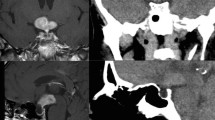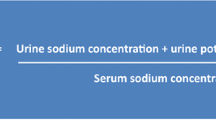Abstract
Background
Primary central nervous system lymphoma (PCNSL) rarely originates in the hypothalamus. Hypothalamic PCNSL can present with various symptoms specific to dysfunction of the hypothalamus, including consciousness disturbance, cognitive impairment, hypopituitarism, and diabetes insipidus (DI). However, it remains unclear whether syndrome of inappropriate secretion of antidiuretic hormone (SIADH) can present as an initial sign of hypothalamic PCNSL.
Methods
Ninety-nine patients with PCNSL were diagnosed between January 2006 and December 2020 at our institutes. The initial symptoms and signs, hypothalamic–pituitary functions, serum sodium (Na) value, Karnofsky Performance Status (KPS) score on admission, and duration from onset to diagnosis were retrospectively investigated from the medical charts.
Results
Eight and 91 patients had hypothalamic PCNSL (hypothalamic group) and PCNSL located in other regions (control group), respectively. Patients’ pathological diagnoses were diffuse large B-cell lymphoma (97 patients) and intravascular lymphoma (two patients). Six patients presented with hyponatremia derived from SIADH or suspected SIADH, and one presented with DI. Statistically significant differences between the hypothalamic and control groups were detected only in the preoperative serum Na values and KPS scores.
Conclusion
SIADH can be an initial presentation of hypothalamic PCNSL. Early detection of hypothalamic PCNSL from SIADH may lead to proper management and improved prognosis.




Similar content being viewed by others
Data availability statement
The datasets generated for this study are available upon request to the corresponding author.
References
Ichikawa T (2018) Primary CNS lymphoma treatment: current status and future directions. Jpn J Neurosurg 27:99–110. https://doi.org/10.7887/jcns.27.99
Ostrom QT, Cioffi G, Gittleman H, Patil N, Waite K, Kruchko C, Barnholtz-Sloan JS (2019) CBTRUS statistical report: primary brain and other central nervous system tumors diagnosed in the United States in 2012–2016. Neuro Oncol 21:v1–v100. https://doi.org/10.1093/neuonc/noz150
Tanki HN, Malik KN, Makhdoomi R, Feroz S, Ramzan AU (2018) Primary hypothalamic lymphoma in an adult male: a case report and literature review. Oman Med J 33:346–351. https://doi.org/10.5001/omj.2018.63
Shin DW, Kim JH, Kim YH, Cho YH, Hong SH (2020) Primary central nervous system lymphoma involving the hypothalamic-pituitary axis: a case series and pooled analysis. J Neurooncol 147:339–349. https://doi.org/10.1007/s11060-020-03422-x
Higashi S, Yamashita J, Fujisawa H, Yamamoto Y, Kadoya M (1990) “Moustache” appearance in craniopharyngiomas: unique magnetic resonance imaging and computed tomographic findings of perifocal edema. Neurosurgery 27:993–996. https://doi.org/10.1227/00006123-199012000-00023
Pascual JM, González-Llanos F, Roda JM (2002) Primary hypothalamic-third ventricle lymphoma. Case report and review of the literature. Neurocirugia (Astur) 13:305–310. https://doi.org/10.1016/s1130-1473(02)70605-2
Lee MT, Lee TI, Won JG, Chau WK, Yang HJ, Li JC, Lin HD, Tang KT (2004) Primary hypothalamic lymphoma with panhypopituitarism presenting as stiff-man syndrome. Am J Med Sci 328:124–128. https://doi.org/10.1097/00000441-200408000-00010
Ikeda T, Hara K, Yamanaka T, Umezu H, Takahashi H, Nishizawa M (2006) A case of primary central nervous system malignant lymphoma developing from the optic chiasma and hypothalamus. Rinsho Shinkeigaku 46:475–479
Prochazka V, Kubova Z, Raida L, Papajik T, Paucek B, Indrak K (2009) Cerebral salt wasting syndrome in a patient with primary CNS lymphoma. Biomed Pap Med Fac Univ Palacky Olomouc Czech Repub 153:219–220. https://doi.org/10.5507/bp.2009.037
Yasuda M, Akiyama N, Miyamoto S, Warabi M, Takahama Y, Kitamura M, Yakushiji F, Kinoshita H (2010) Primary sellar lymphoma: intravascular large B-cell lymphoma diagnosed as a double cancer and improved with chemotherapy, and literature review of primary parasellar lymphoma. Pituitary 13:39–47. https://doi.org/10.1007/s11102-009-0196-9
López Navia AM, Galván Díaz B, Tejera Pérez C, Hernández Lavado R, Morales Pérez F (2014) Hypothalamic evanescent lesion by diffuse large B-cell lymphoma. Endocrinol Nutr 61:335–336. https://doi.org/10.1016/j.endonu.2014.03.005
Cellina M, Fetoni V, Baron P, Orsi M, Oliva G (2015) Unusual primary central nervous system lymphoma location involving the fourth ventricle and hypothalamus. Neuroradiol J 28:120–125. https://doi.org/10.1177/1971400915576671
Takase R, Nakano Y, Otsuka F (2020) Malignant lymphoma developed in the hypothalamus. Intern Med 59:1009–1010. https://doi.org/10.2169/internalmedicine.3655-19
Antic D, Smiljanic M, Bila J, Jankovic S, Balint MT, Andjelic B, Mihaljevic B (2012) Hypothalamic dysfunction in a patient with primary lymphoma of the central nervous system. Neurol Sci 33:387–390. https://doi.org/10.1007/s10072-011-0726-x
Calanchini M, Cudlip S, Hofer M, Byrne J, Fabbri A, Grossman A (2016) Chordoid glioma of the third ventricle: a patient presenting with SIADH and a review of this rare tumor. Pituitary 19:356–361. https://doi.org/10.1007/s11102-016-0711-8
Cui H, He G, Yang S, Lv Y, Jiang Z, Gang X, Wang G (2019) Inappropriate antidiuretic hormone secretion and cerebral salt-wasting syndromes in neurological patients. Front Neurosci 13:1170. https://doi.org/10.3389/fnins.2019.01170
Olchovsky D, Ezra D, Vered I, Hadani M, Shimon I (2005) Symptomatic hyponatremia as a presenting sign of hypothalamic-pituitary disease: a syndrome of inappropriate secretion of antidiuretic hormone (SIADH)-like glucocorticosteroid responsive condition. J Endocrinol Invest 28:151–156. https://doi.org/10.1007/BF03345358
Rubacha M, Tubbs RS, Li R, Rocque B, Blount JP (2015) Pediatric central nervous system solitary fibrous tumor: case report. Childs Nerv Syst 31:2379–2381. https://doi.org/10.1007/s00381-015-2761-z
Schrier RW, Berl T, Anderson RJ (1979) Osmotic and nonosmotic control of vasopressin release. Am J Physiol 236:F321–F332. https://doi.org/10.1152/ajprenal.1979.236.4.F321
Ma SK, Lee KH, Kim SW (2014) Hyponatremia associated with primary central nervous system lymphoma. Clin Exp Nephrol 18:170–171. https://doi.org/10.1007/s10157-013-0839-z
Akhtar S, Cheesman E, Jude EB (2013) SIADH and partial hypopituitarism in a patient with intravascular large B-cell lymphoma: a rare cause of a common presentation. BMJ Case Rep. https://doi.org/10.1136/bcr-2012-007147
Nelson DF, Martz KL, Bonner H, Nelson JS, Newall J, Kerman HD, Thomson JW, Murray KJ (1992) Non-Hodgkin’s lymphoma of the brain: can high dose, large volume radiation therapy improve survival? Report on a prospective trial by the Radiation Therapy Oncology Group (RTOG): RTOG 8315. Int J Radiat Oncol Biol Phys 23:9–17. https://doi.org/10.1016/0360-3016(92)90538-s
Ferreri AJ, Blay JY, Reni M et al (2003) Prognostic scoring system for primary CNS lymphomas: the International Extranodal Lymphoma Study Group experience. J Clin Oncol 21:266–272. https://doi.org/10.1200/JCO.2003.09.139
Ferreri AJ, Reni M (2005) Prognostic factors in primary central nervous system lymphomas. Hematol Oncol Clin North Am 19:629–649. https://doi.org/10.1016/j.hoc.2005.05.005
Abrey LE, Ben-Porat L, Panageas KS, Yahalom J, Berkey B, Curran W, Schultz C, Leibel S, Nelson D, Mehta M, DeAngelis LM (2006) Primary central nervous system lymphoma: the Memorial Sloan-Kettering Cancer Center prognostic model. J Clin Oncol 24:5711–5715. https://doi.org/10.1200/JCO.2006.08.2941
Funding
No funding was received for conducting this study.
Author information
Authors and Affiliations
Contributions
MO designed the study, analyzed data, and wrote the paper. YH designed the study and co-wrote the paper. YS advised on the study and edited the paper. NO analyzed the data. MN supervised the study.
Corresponding author
Ethics declarations
Conflict of interest
The authors declare no competing interests.
Ethics approval and consent to participate
This study was approved by the medical ethics committee at Kanazawa University (approval number: #2016-244 [2227]) and Kanazawa Medical University Hospital (approval number: #1556), and most participants provided written informed consent. Medical Ethics Committee of Kanazawa University waived the requirement of an informed consent considering the retrospective evaluation of patient data for the remaining patients, and written informed consent was not obtained from a relative/guardian. This study was performed in accordance with the Declaration of Helsinki and in compliance with requirements for retrospective studies on human subjects.
Additional information
Publisher's Note
Springer Nature remains neutral with regard to jurisdictional claims in published maps and institutional affiliations.
Rights and permissions
About this article
Cite this article
Oishi, M., Hayashi, Y., Sasagawa, Y. et al. Syndrome of inappropriate secretion of antidiuretic hormone as an initial sign of primary central nervous system lymphomas in the hypothalamus. Acta Neurol Belg 123, 415–422 (2023). https://doi.org/10.1007/s13760-022-01985-2
Received:
Accepted:
Published:
Issue Date:
DOI: https://doi.org/10.1007/s13760-022-01985-2




